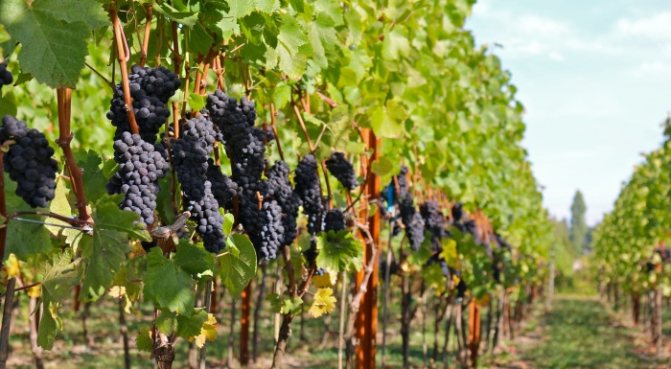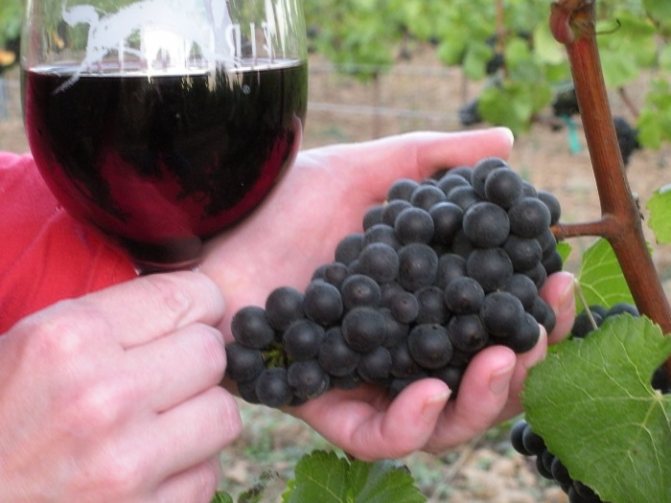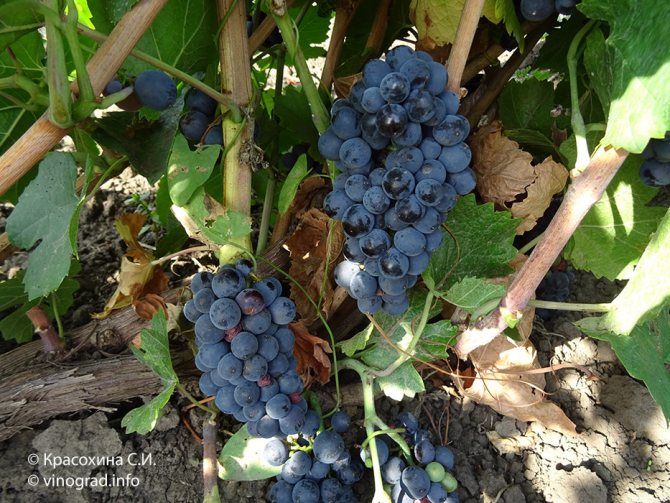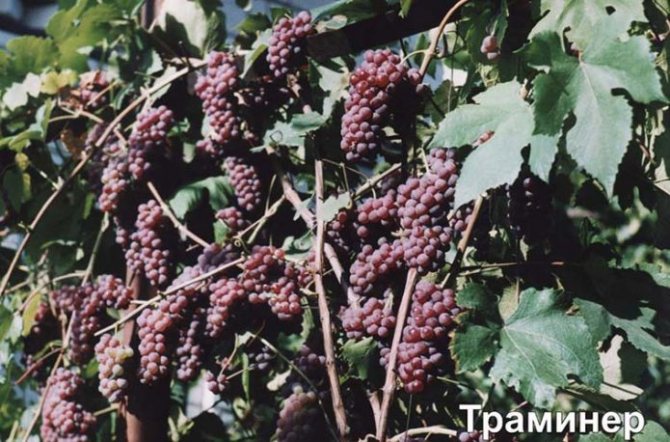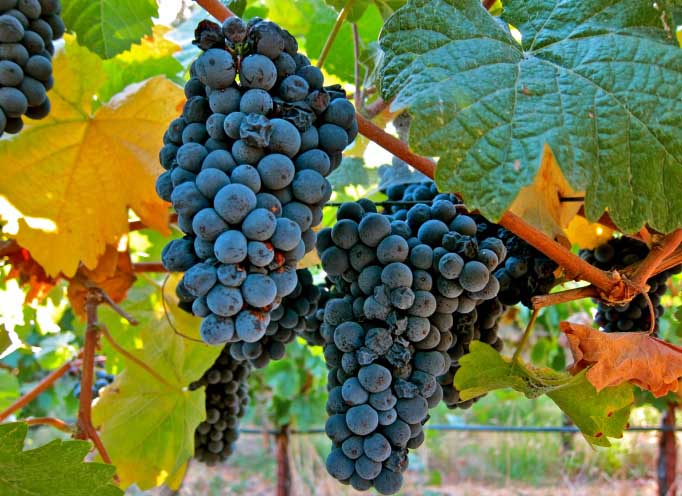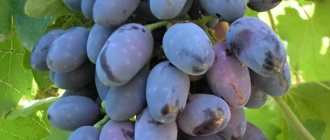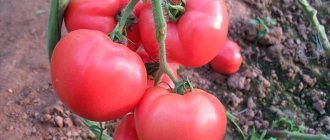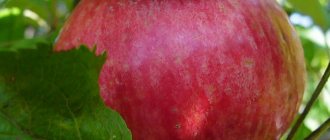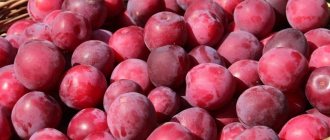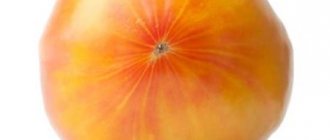Description of the Pinot Noir grape variety
This technical grade matures (to technical maturity) in about 140-150 days. Technical maturity usually occurs in September. Today it is cultivated mostly in France, Germany, USA, Italy, Austria, Argentina, Japan and some other countries.
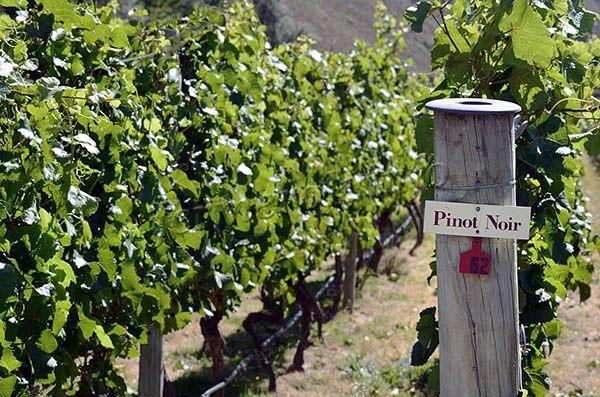
Bushes are weak, with erect shoots
Bushes are weak, with erect shoots. The young vine is green, the annual one is green-brown, and the old one is stiff and brown in color. The leaves are medium in size, rounded, can be slightly corrugated or finely bubbly, the color is always rich green. Flowers are bisexual.
Important!
Pinot Noir is valued not for the yield or quality of the bush or vine, but for the taste and aroma of the berries.
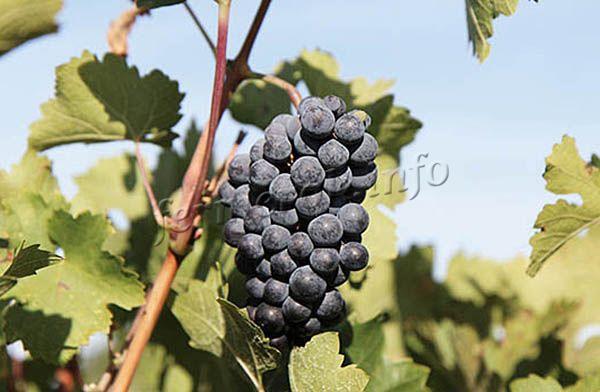

Small bunch, 7-12 cm long and 5-8 cm wide, in the form of a cylinder
The bunch is small, 7-12 cm long and 5-8 cm wide, in the form of a cylinder. It is usually very dense. The mass of a bunch can vary from 65 to 120 g. The berries are medium in size - 14-16 mm in diameter, 1.3 g in weight, round. The color of the skin is dark blue with a bluish bloom. The rind is thin but firm. The pulp is high in juice, tender, with a harmonious, sweet and sour taste. There are 2-3 seeds in one berry.
Characteristics of the Pinot Noir grapes
Check out these articles as well
- Cabbage varieties for pickling and storage
- The best cherry varieties for the Moscow region
- Plant growing
- Zucchini variety Gribovsky 37
Below are the characteristics of the Pinot Noir grape variety with all its advantages and disadvantages.
- The bushes do not grow very large, develop with medium vigor, which makes it easier to care for.
- The yield is low - 50-60 c / ha, but this grape is still highly valued.
- Gray rot, mildew and mildew are affected in an average degree. It is very often affected by leafworm and phylloxera.
- The variety can be peas.
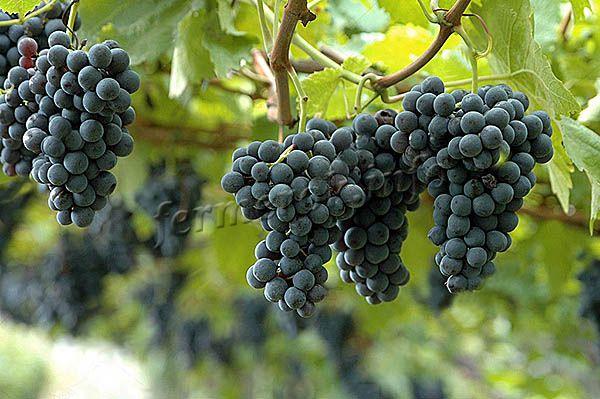

The yield is low - 50-60 centners-ha, but this grape is still highly valued
- The eyes open in early spring, so they are sometimes damaged by recurrent frosts.
- Winter hardiness is quite high (-25 degrees), but even if the vine was damaged by frost, in the spring the bush quickly departs and starts growing again.
- The taste is pleasant, refined. Sugar content - 21.4 g / 100 ml, acidity - 7.7 g / l.
Diseases and pests
According to gardeners and farmers, most often grapes are affected by fungal diseases.
Oidium
Fungal infection of the aboveground part of the bushes. It manifests itself as a white, mealy bloom on leaves, ovaries, shoots and berries, accompanied by an unpleasant, rotten smell. The disease spreads quickly, can completely destroy the crop and harm the plant.
As a treatment, spraying of bushes and soil with biological and chemical means of protection is used.
Mildew
The fungus appears in the form of dark spots on the leaves and a grayish bloom on the berries. The bushes are treated with fungicides and sulfur-based preparations.
Gray rot
Gray rot can destroy the entire berry crop in a short time. It manifests itself in the form of gray mold and dark spots.
To combat the disease, agents based on fungicides, copper and sulfur are used.
Phylloxera
Grape aphid of American origin, affects the aboveground and underground parts of the plant. If you do not take sulfur in a timely manner, the grape bush will die.
For treatment, spraying of the soil and plants with preparations based on insecticides is used.
Leaf rollers
The pest is especially dangerous at the stage of caterpillars, which eat up the entire green mass of the plant, from leaves to berries.
To combat the leafworm, chemical means of protection based on insecticides are used.
Resistance to diseases such as oidium and mildew, as well as Pinot rot, is quite high. Also, he is not at all afraid of such a parasite as the grape leafworm.
But the variety is extremely unstable to phylloxera. Bushes with their own roots are affected and invariably die from root damage at 6 years. To prevent this from happening, it is grafted onto bushes that have resistance to this pest.
To avoid chlorosis, to which he has a tendency, it is necessary to carry out operations on the green parts of the bush, reducing them or completely removing them, especially in humid climates.
Pinot Noir is resistant to powdery mildew, mildew and gray rot, poorly resistant to phylloxera, however, grafting on grapes with resistance will increase this indicator. When affected by this disease, the plant dies after 5-6 years.
Prevention is widespread - by cutting off the greenery, which increases the ventilation of the bush.
It is weakly prone to pests.
The Pinot Noir grape is used to make high quality wines and champagnes. It is rarely mixed with other varieties, as it itself is revealed in different ways, making it possible to experience different flavor notes.
Growing features
Pinot Noir grapes are quite sensitive to planting conditions. For example, when grown in hot areas, the grapes will ripen too quickly, without having time to develop a bouquet of taste and aroma. He is picky about the quality of the soil, illumination. For growing this variety, it is best to choose the southern areas, you can also on the slopes. The most acceptable soil is limestone with clay, it should be loose. The acidity is adjusted to pH 6.5-5.
Important!
If, as it grows, the bush is heavily overgrown with foliage, you need to cut off all the excess so that the bunches have access to sunlight.
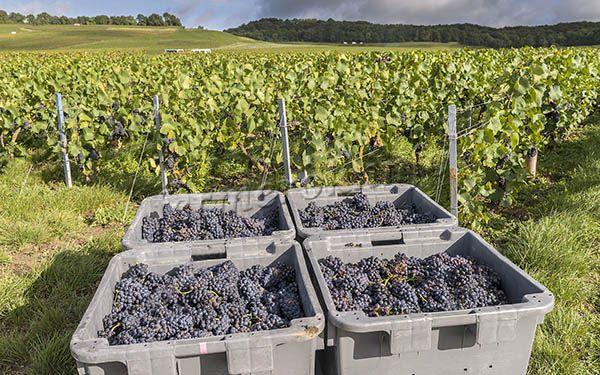

For growing this variety, it is best to choose the southern areas.
For spring planting, the pits are prepared in the fall. They are dug at a distance of 80-100 cm. A distance of 1-1.2 meters is maintained between the rows. If the planting is autumn, then the pit is made in 3-4 weeks. Drainage is done in the pit, then fertilizers are applied (250 g of wood ash, 250 g of nitroammofoska). Saplings are planted carefully so as not to damage the roots. After planting, the soil is compacted and watered. From above, it is advisable to mulch the root zone by 5-10 cm with peat or straw.
Winegrowers reviews
Despite the fact that on an industrial scale this variety is grown as a non-covering crop, in the Krasnodar Territory, in a large area of other regions of our country, the Pinot Noir grape is not zoned. Here he is assessed as unpromising and requiring high costs for shelter. In addition, widespread use is hampered by low yields. The variety has a tendency to set a stepchild's harvest.
Experienced growers weekly throughout the summer sprinkle the bushes with small doses of zircon and gummate, and in the spring, the use of epin gives a good result.
Read more:
- Grapes rhombic variety description photo reviews
- Grapes Count of Monte Cristo variety description care features
- Frumoasa Albe grapes description of the variety features of care
- Grapes Dubovsky pink: variety description, photo
Care of the Pinot Noir variety
We recommend reading our other articles
- Codryanka grapes
- Sheep breeding as a business
- The best goat breeds
- San Andreas strawberry variety
The best Pinot Noir grapes are grown in Burgundy.The reason is not only climate or land, but also care. Only by observing all the standards of care can you get a high-quality harvest.


Spraying, feeding and watering Pinot Noir grapes
- Watering is not carried out very often. It is advisable to make ditches near the bushes, into which watering is carried out. You can also lay a drip system - it will be even better for the given grape. The first watering is carried out in early spring (if there was little snow, then in March, and if there was a lot - in April). During flowering and 2 weeks before it, watering stops altogether. Water consumption for an adult bush in summer is 40-60 liters.
- Top dressing is applied 3-4 times a year from the age of 3. The first feeding is carried out before flowering (50 g of nitrophoska per bucket of water), the second feeding is needed 2 weeks before the formation of berries (20 g of potassium magnesium and ammonium nitrate per bucket of water). The third feeding is done 2.5 weeks before harvest (20 g of potassium salt and the same amount of superphosphate per 10 liters of water). After harvesting, you can carry out the last fertilizing of the year. Fertilizers are simply embedded in the soil when digging. You can use superphosphate, humus.
- For this grape, it is extremely important to carry out preventive treatments against pests and diseases throughout the season. Treatments are done at intervals of 1-2 months.
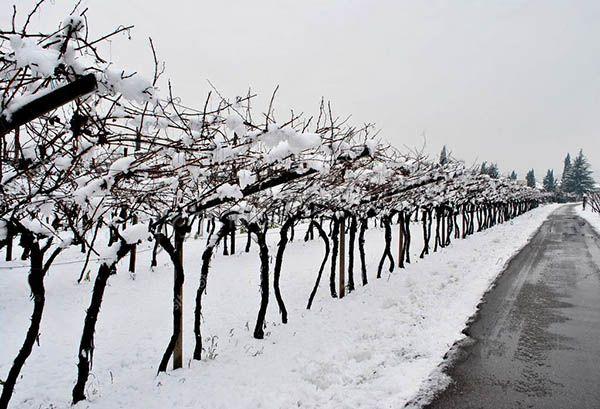

For the winter, Pinot Noir grapes are sheltered only in areas with cold winters
Important!
Water for watering Pinot Noir grapes is taken at room temperature.
- The formation of the bush is carried out in the south with a low stem, and in the north - with a high stem with long sleeves. Shoots are cut into 7 eyes. Pruning is done with a very sharp pruning shear soaked in a disinfectant solution. Once a year, you need to cut off all excess shoots, diseased, non-fruiting pagons.
- For the winter, Pinot Noir grapes take refuge only in areas with cold winters. In this case, the land must be mulched with peat or humus, and the bushes themselves must be covered with insulating material.
Planting and leaving
The variety takes root well if the weather conditions are appropriate.
Selection of seedlings
It is better to purchase seedlings just before planting. They must have healthy, strong, developed roots, which resemble raw potatoes at the break. Look for specimens with a smooth, healthy, undamaged trunk. Under the bark, the seedling should be a deep green color. When buying, you should put pressure on the eyes, if they fall off, you should refuse to purchase.
It is better to purchase seedlings from special nurseries or from trusted suppliers. Growing enthusiasts often exchange seedlings with each other. Numerous forums on the Internet have advice on the specifics of agricultural technology.
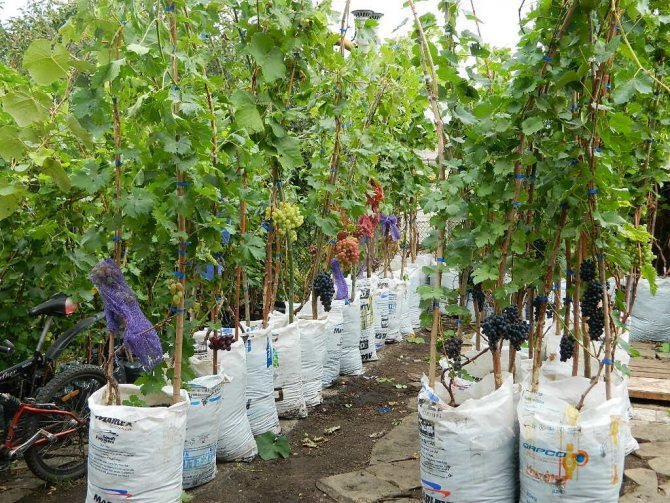

Requirements for soil and planting space
The grapes prefer fertile soil. The quantity and quality of the crop directly depends on this. It does not tolerate acidic and saline soils. Grows well in sunny, elevated or well-drained areas with neutral or alkaline soil. The distance between bushes in a row and aisles for Pinot Grigio is about one meter. Planting hole - 80x80 centimeters.
Before planting, the roots are soaked in water for a day, pruned if necessary and treated with a clay chatterbox. If the soil is not too fertile, humus is added to the bottom of the hole. The soil in the hole is poured with a slide, the seedling is carefully placed in the center and the roots are evenly spread.


Important: in the first 3 years, this grape variety requires particularly gentle care. After planting, the soil is compacted and the plant is watered.
Soil loosening
The variety is very susceptible to weeds, the planting must be systematically loosened, providing good oxygen access to the roots.
Watering
During the period of active growth, the grapes should be watered, adding at least 10 liters of water under each bush. Water is usually watered once a month, but adjusted for weather conditions. Organization of drip irrigation is the best option for the Pinot Grigio variety. In August and September, the plants are not watered.The last watering is done after harvest, in early October.
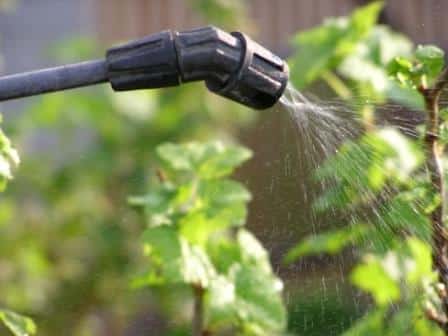

Top dressing
The plant is fed three times per season. In the spring, during the period of bud swelling, nitrogen fertilizers are needed, you can use a 5% solution of bird droppings. The second top dressing is done before flowering: use Kemira, Plantofol or another ready-made complex for grapes, in accordance with the manufacturer's instructions. The third top dressing for this variety is made in September, after the harvest. Fertilized with organic matter.
See also
Description and characteristics of the Gala grape variety, history and subtleties of cultivationRead
Pruning and clothespin
Pinot Grigio needs regular pruning. Cut the bush in the spring, after removing the covering material. Remove dry branches, cut off excess shoots with scissors. The vine is tied to pre-prepared wooden pegs. The clothespin is carried out in the spring, breaking off strong branches, slightly above 10 knots.
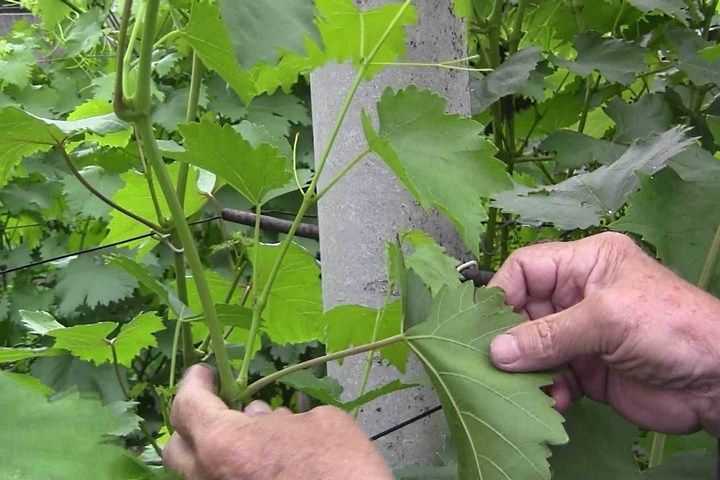

Seasonal disease prevention
Since the variety is susceptible to mildew and mildew disease, the plants should be regularly sprayed. This is done with Bordeaux mixture or fungicides (Horus, Topaz, Strobi). After the formation of the ovary, during the period of berry filling, spraying is not carried out.
Autumn processing is carried out before the grapes are sheltered for the winter in order to prevent the preservation of spores and the development of diseases in the next season.
Bunch care
They are protected from birds by pulling on a metal mesh. To protect against wasps, poisoned bait is hung in the vineyard, wasp nests are found and burned. If the bunches are affected by diseases, they are destroyed in a timely manner in order to prevent the spread of the disease.
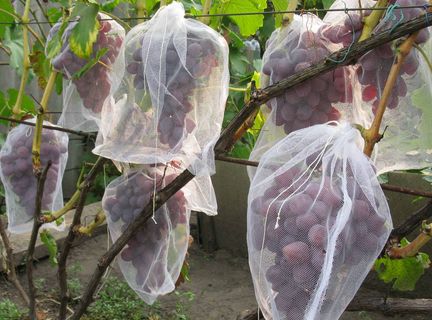

Preparing creepers for winter
Pinot Grigio needs cover. It is good if a special trench is dug along the rows of grapes to cover the vine. Then it is simply laid for the winter and covered with earth, film, spruce branches or other covering material. Before the shelter, wilted leaves and dry branches are removed, the vine is treated from diseases and pests.
Harvesting and processing
The berries ripen from about mid to late September, depending on the region and climate. You need to collect the bunches by hand, carefully removing them from the vine. These grapes are not subject to long-term storage. It is advisable to start processing immediately after harvesting.


Used grapes Pinot Noir to make high quality table wines
Used grapes Pinot Noir for the manufacture of high quality table wines or good champagne wine materials. To get the maximum tannin values, the berries are pressed together with a brush. This grape is made from both white and red wine.
Origin story
France is considered the birthplace of this famous technical grape, in particular the province of Burgundy, where people have long been engaged in winemaking. Based on the results of the DNA examination, the alleged "parents" of the variety were identified. Probably, it was similar to him, close French clone "Pinot Meunier" and grapes "Traminer". The shape and color of the bunches, which outwardly resemble a dark (noir) pine cone (pinot), gave the name to this famous red grape. Subsequently, the variety began to be cultivated almost everywhere.
Reviews of the Pinot Noir grape variety
Winegrowers know and love the Pinot Noir variety for its amazing bouquet of taste and aroma.
- Egor Volkov: “I have been growing 15 Pinot Noir bushes for over 10 years. I like the variety, first of all, for its taste - it turns out a unique wine! The yield, of course, is low and this is the main disadvantage, and you need to be able to take care of this grape, but it is highly valued and all the extra harvest can be sold without problems. I noticed that he loves fertilizers very much, especially nitrogen. For all 10 years there were no diseases, but every 2 months I process the bushes from fungi and viruses.But there were pests, but special preparations for them help well ”.
- Vadim Krylov: “On my site, Pinot Noir is the main grape. I only use it for making homemade wine. He has no competitors here! The only thing I don't like about this variety is that it is weather dependent. If summer fails, then the taste will be simple and the aroma will be weak. So you need to be able to create the best conditions for him. "
- Natasha Savina: “The Pinot Noir grape variety is good both in taste and in cultivation. There is not much harvest, but enough for personal needs. We make wine from the best parties, and from the bad ones we make homemade juice. In terms of care, there are no special problems, but you need to regularly fertilize it and treat it from diseases, otherwise the entire crop may be lost. In addition, it is desirable to make a drip irrigation system, so it will be easier to irrigate if the plantation is large. "
Selection Tips


1.First of all, pay attention to the country of origin. Geographic location, soil quality, climate are all very important for growing grapes. Accordingly, the wine here will be of better quality. Give preference to European countries. For example, France (the best wine will be from Burgundy, Champagne, Bordeaux), Germany, Italy (Tuscany, Veneto, Friuli). Exception: America (Oregon Napa, Sonoma: California), which has reached high heights in the production of white wines, and Australia (Shiraz).
2.Look at the grape variety. By giving preference to a certain variety, you can choose a wine that suits your mood more. For example, white wines are lighter and more refreshing; red - for special events, special evenings.
3.Year of issue. A quick tip: aging is not always good for wines. For example, it is better not to put whites on the back burner, since over the years it loses all its taste and aroma properties. Whereas red wines only get better over time.
4.Attention! Label! Most people don't do justice to bottle label research. However, in vain ... The date of manufacture and the inscription "natural wine" should be indicated on the neck of the bottle. If this is absent, then you have a fake in the form of synthetics (powder). In the case when “special wine” is indicated, this is also a sure sign of low-quality wine made from concentrates.
5.Wine storage areas. Professionals advise against buying wine in a store, which is stored under soffits. Lamps literally "boil" the wine and it loses all its properties. It will be very harmful for sparkling wines and champagne.


